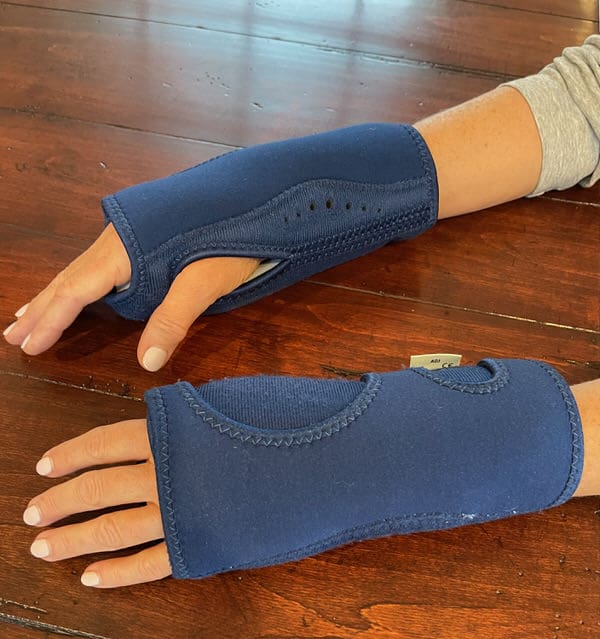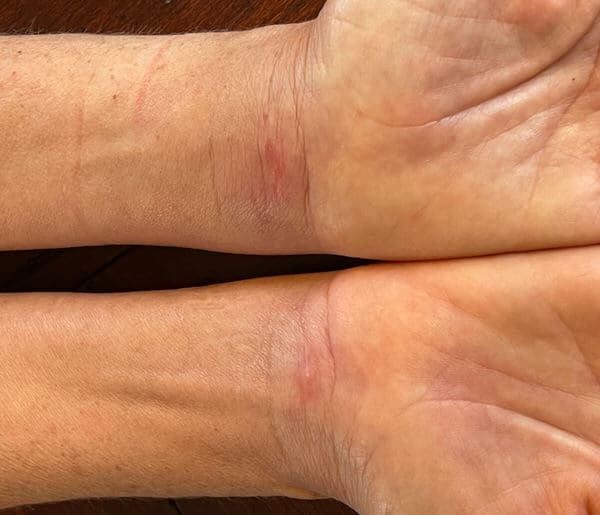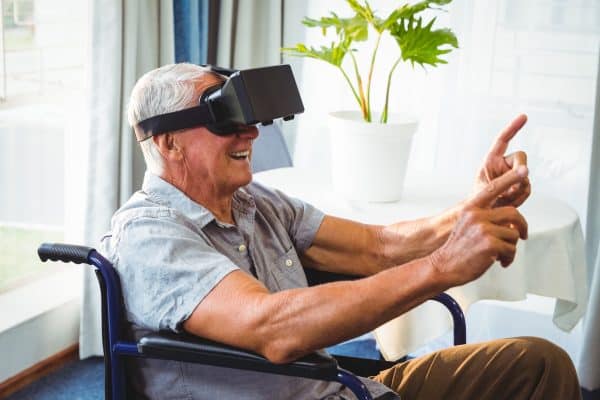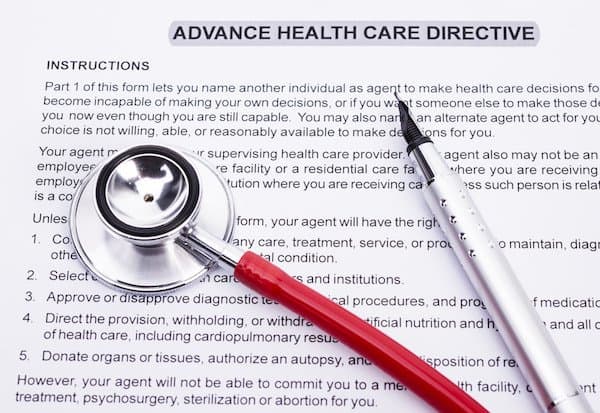Carpal tunnel syndrome (CTS) affects three times as many women as men, particularly post-menopausal women in their fifties. Carpal tunnel release surgery, a simple procedure that relieves swelling and pain in the hand, is the most often performed hand surgery in the United States. In this post, I’ll tell you about my experience with CTS and my carpal tunnel release surgeries. I hope my story will help you decide how you want to deal with carpal tunnel pain you might have.

What’s Carpal Tunnel Syndrome (CTS)?
CTS is a problem that affects over 6 million American adults, three-quarters of them female. In CTS, there is swelling of the carpal tunnel ligament running across the base of the palm that puts pressure on the medial nerve. This is the nerve that runs from the hand up the middle of the arm.
CTS symptoms are pain in the wrist and palm, accompanied by numbness and tingling in the fingers. Particularly in the thumb and first two fingers. These symptoms may start out as merely annoying, but if left untreated, they can balloon over time to cause significant pain that inhibits carrying out your daily activities.
Who gets CTS?
As mentioned above, women with CTS outnumber men 3 to 1. There is limited research on why this is the case, but scientists point to the smaller bones in women’s hands, possible genetic links, as well as hormonal shifts during pregnancy and menopause — all of which can reduce the space through which tendons and ligaments must pass, thus exerting pressure on the medial nerve.
CTS peaks among women in their 50s, around the age of menopause. This may happen at least in part because estrogen production decreases around this time. But increasing CTS at this age might also stem from years of wear and tear on the body. In general, older people experience CTS at higher rates than younger people.
My experience with CTS: Diagnosis
CTS issues off/on for over a decade
I had problems with tennis elbow 10-15 years ago, and they morphed into wrist pain. But for a long time, I’d been able to keep the wrists feeling okay by using braces on one or both of them at night.
Earlier this year, however, my carpal tunnel pain got much worse very quickly. I’m not sure why this happened. My only new activity was learning to play golf — a sport that involves a lot of wrist action. Maybe I was getting a bit too enthusiastic about practicing. Or maybe my hands and wrists were suffering from over 50 years of carrying, chopping, cooking, knitting, typing, and so on.
Hand specialist visit
My doctor evaluated my range of motion and finger sensitivity with a short physical exam. He tested for numbness by having me put both hands on the table, close my eyes, and then wiggle the finger he was brushing with a little filament. In my experience with CTS, there was a distinct difference between fingers: my thumb and first two fingers were more numb than my ring and pinky fingers were.
My doctor surmised that my CTS was probably not due to any one thing, but rather the multiple activities I’d done over time. That made sense to me. While I couldn’t pinpoint the cause of my worsening CTS problems, I did know was that it was getting harder and harder to open my fridge or grip small objects. I couldn’t write with a pen or squeeze a lemon, either.
My experience with CTS: Initial treatment options
Wrist splint, other non-invasive therapies
The first line of defense in treating CTS is to wear a wrist splint or brace to bed. This prevents you from bending your hand into awkward positions and keeps your wrist straight while you sleep. Which in turn helps you recuperate overnight. You may feel a bit numb in the morning, but things are fine as the day progresses.
Other interventions include yoga and stretching, over-the-counter pain relievers, and attention to ergonomics at your desk, car, etc.
Nighttime wrist splints, stretching and an ergonomic computer setup kept my CTS in check for years. But a few months ago, things got worse.
Cortisone injection
If you get to a point where the nighttime splint isn’t enough to ward off carpal tunnel pain, your doctor can try a cortisone injection in the palm. This is done in the office. She first numbs your wrist and palm with an anesthetic injection. This hurts, but not for long. Then she inserts a long needle from your wrist toward your palm to inject steroid medication into your carpal tunnel ligament.
Within 24 hours, the steroid should reduce swelling in the ligament and lower your pain. In my experience with CTS, the cortisone shot reduced the pain in my hand almost immediately. I was overjoyed: I got a good night’s sleep for the first time in nearly a month.
But within two weeks, the pain started coming back.

My experience with CTS: the decision to do surgery
My doctor said that my body’s initial positive response to the cortisone injection was a good sign, that it showed my problem was CTS and it could be relieved by reducing pressure on the medial nerve. Unfortunately for me, the injection’s benefit didn’t last very long.
To achieve a more stable resolution, I needed carpal tunnel release surgery. This is a simple procedure performed on an outpatient basis. The surgery itself usually takes only 15-20 minutes. The surgeon makes an incision in your wrist and uses a special tool to “release,” i.e., cut the carpal tunnel ligament that runs across your palm. This reduces pressure on your medial nerve and thus greatly lowers your carpal tunnel pain.
Endoscopic vs. open carpal tunnel release
There are two main types of carpal tunnel release surgery. Both achieve the same result but differ by type of incision. In an endoscopic procedure, the hand surgeon uses a tiny camera inserted through a small incision in the wrist to guide her as she navigates a special surgical tool to cut the ligament in your palm that’s pressing down on your nerve.
“Open” surgery involves a larger incision and a more direct sighting of the area to be cut. Some surgeons prefer this method, although endoscopic procedures are on the rise as technology continues to improve. And notably, the initial recovery from endoscopic surgery is generally faster.
My surgeon chose to do an endoscopic procedure on me. I checked in at the same-day surgery center, went through the initial screening, and then changed into my hospital gown, socks and cap. (Thank goodness they prohibited photos in the pre-op area: it wasn’t a good fashion moment!)
Anesthesia in carpal tunnel release
While the surgeon and anesthesiologist may opt to use general anesthesia, carpal tunnel release surgery often takes place using local anesthetic only. A friend who had this surgery told me that she was awake and aware of what they were doing the whole time. She said the first injection of local anesthetic hurt, but after that, she felt nothing.
I counted myself lucky, however, that my anesthesiologist gave me a sedative before any local anesthetic or cutting began.But when I woke up in the recovery area, I felt MUCH better than at times when I’ve received general anesthesia.
The doctor came by to check on me, and I was able to talk somewhat coherently with him — I even remembered our conversation later. In all, I spent about 3-4 hours at the ambulatory surgery center. When I was ready to go, a staff member called my husband, and he drove me home.
My experience with CTS: recovery
First few days
I went home with a dressing on my wrist and instructions to keep it dry for 4 days. I could still shower by wrapping the wrist in plastic wrap and then covering the whole arm and hand with a plastic bag to keep out the water. It was hard to shampoo my hair with only one hand, but showering felt more refreshing than doing a sponge bath.
I had to keep my hand propped up above my heart for a few days to reduce swelling. This was no problem — actually, it gave me a great excuse to be lazy.
I also had to do hand exercises to regain my range of motion. These were things like closing and spreading my fingers, or balling them up in a fist and then opening them wide. The exercises took just a minute or two. I set my watch to beep on the hour and remind myself to do the exercises. At first the motion hurt, but that lessened over time.
For pain control, I was fine with only ibuprofen and acetaminophen. My wrist initially hurt mostly around the incision site. I bruise easily, and at one point I had bruises running down my palm and into my lower arm.

Days 4-13
I didn’t need regular pain medication after the first few days, but I continued to take Tylenol at night to help me sleep. However, discomfort continued in the heel of the hand where the carpal tunnel release had happened. It wasn’t too bad — just a dull throbbing from time to time.
I was permitted to use my affected hand for light activities right away, like typing for short periods of time. After a couple of days, I resumed driving. But I wasn’t allowed to chop vegetables or do racquet sports, weights, or anything that involved grip strength. In fact, I wouldn’t have been able to do them anyway: my hand was too sore to hold a knife, pick up a heavy object or grip the stair rail.
Post-op check Day 14
Two weeks after surgery I saw the physician assistant (PA). She evaluated my range of motion by watching how well I could do the hand exercises they’d assigned me. Some patients benefit from seeing a hand therapist. But in my case, this wasn’t necessary.
I asked about getting one of those squishy balls, something I thought I should squeeze to regain my strength. My PA, however, advised me NOT to bother with it. Apparently, some patients overdo the squishy ball work and hamper their recoveries. All I needed to rebuild my hand strength, she said, were my normal activities.
Days 14-30
I was allowed to resume swimming about 2-3 weeks after my surgery, once the incision had fully healed. Then at the 1-month mark, I was cleared to start doing more “heavy” activities like chopping vegetables and holding dumbbells.
At this point, I basically let pain be my guide. I had to be careful not to do too much chopping at one time, for example. And I didn’t feel strong enough to return to the golf range just yet.
My experience with CTS: my other hand
I decided I wasn’t going to let carpal tunnel pain in my left hand get as bad as it had in my right one before I sought help. So at the 2-week post-op visit for my right hand, I tentatively scheduled surgery on my left one. They held onto a surgery slot for me and set an appointment for my surgeon to evaluate my progress from the first surgery, as well as determine whether I was a candidate to do the same procedure on the left hand.
The good news for me was that my hand surgeon decided we could go ahead with the second carpal tunnel release surgery, even though my left-hand CTS wasn’t as bad as the right hand had been before surgery. The doctor also noted that the self-absorbing sutures he’d used on my right wrist seemed to have irritated my skin, causing red bumps and itching. So he decided to use nylon sutures on my left wrist. His PA would remove these sutures at my 2-week post-op appointment.
All this worked out well. By the time I had my second carpal tunnel release surgery, I was familiar with the drill. Three weeks after the second surgery, the left incision looked as good as the right hand looked 9 weeks after surgery. Clearly, the non-irritating nylon sutures made a difference in my case. I’ve continued to reduce the scars with self-massage and scar tape like this one.

Should you have carpal tunnel release surgery?
Second recovery much smoother
It was easier to go through recovery with my non-dominant hand. I could still cook, pick up and carry things with my right hand. While it may seem extreme to do one hand right after the other, I preferred to spend a few months of modified activity all at once, rather than recuperate fully from the first surgery and then have to turn around and have it on the other hand a year or so later.
This is a quick surgery with little downtime. If you’re having significant carpal tunnel pain that affects your normal activities, I think it makes sense to go ahead and do the surgery. Carpal tunnel release offers a more lasting solution than cortisone injections. In fact, when cortisone shots aren’t providing sustained relief, doctors hesitate to prescribe additional steroid injections in the same area of the body. Repeated cortisone injections can damage body tissues over time.
Surgical results
The Mayo Clinic states that 90% of people who’ve had carpal tunnel release surgery experience significant relief of symptoms, but only 50% of post-surgical patients experience complete relief. At the same time, pain warranting a second carpal tunnel release surgery is indicated in very few cases.
I think I’m in the category of the 90% who experience significant relief, but also the half whose symptoms don’t completely go away. Continuing to wear wrist splints at night might be something I have to do indefinitely. Yet in general, I’m optimistic that my surgeries will continue to provide me with relief from pain and a return to the things I enjoy doing.
Go for the cure
It’s an easy surgery and recovery, as well as a long-term solution to CTS’s cause rather than its symptoms. Based on my experience with CTS, I’d recommend getting this simple outpatient procedure.
Of course, every case is different. Talk with your doctor and educate yourself on the risks. But don’t be afraid to go forward with the procedure if your MD advises it: pain-free hands are only a few months away.





